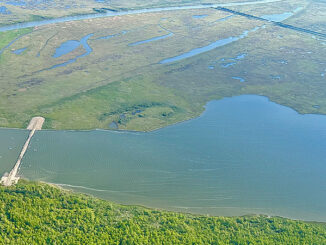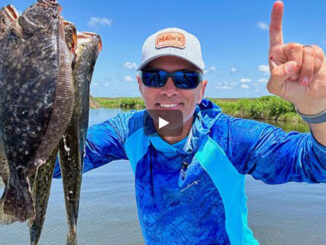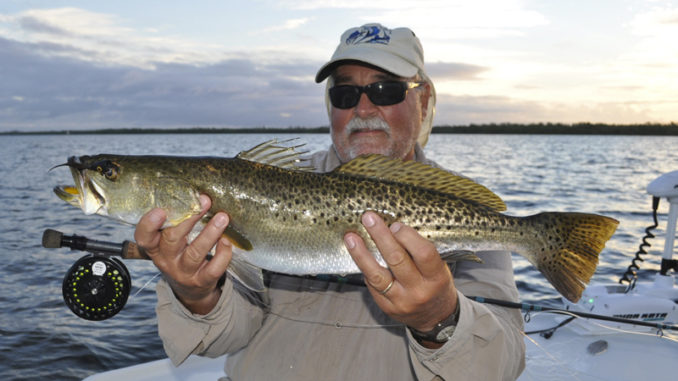
This Houma fly fisherman hammers speckled trout this time of year in the deep holes off Highway 1 near Grand Isle. But you can use his tips and tactics, no matter how you fish.
At his camp on Grand Isle the night before the trip, when Victor “Ted” Tedesco III told me how early he wanted to get up, I shuddered.
The predicted low for the night was 30º F — and we were in kayaks.
Probably sensing my hesitation, the retired doctor and current Terrebonne Parish Coroner told me he wanted to be sure to beat everyone else to his favorite spots.
We launched into the Forbidden Hole off Highway 1 in total darkness. By starlight, he led the way to a shallow gap in the bank 100 yards or so wide. Later, by daylight, I could see that it was the largest cut in the southern bank of the hole.
On first cast, his rod bowed when a 13-inch speckled trout took the fly. On his third or fourth cast came another. Then another — and the sun was still well below the horizon.
Improving light let me see how he was set up. His kayak was anchored in 10 or 11 feet of water and he was casting to water 3 feet deep on the point formed by the eastern end of the cut, a point he pet-named “3-Pound Point.”
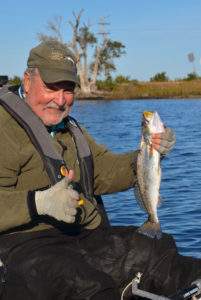
The retrieve of the fly was made down a sharp drop-off by stripping back short strokes of fly line by hand. He held the rod in his right hand and the fly line was held loosely by the forefinger and thumb of the same hand.
He pulled the line in with the fingers of his other hand, a process called “stripping” by fly fishermen. The stripped line coiled lazily in the bottom of his kayak.
“Let your fly sink 4 to 8 seconds, then start stripping,” he advised. “Vary the speed until you find out what’s working. Pause often during the retrieve. You get a lot of strikes when you start stripping again.
“And pause after missed strikes. Here again you get strikes when you start the retrieve again.
“When the fly gets close to the boat, don’t rush to make another cast. Pick it up deliberately and slowly. I’ve gotten a lot of strikes picking up.”
Before 7 a.m., three vehicles had pulled on the Hole’s shoulder, with a total of five fishermen. By that time, the sun came out blindingly bright and the bite at 3-Pound Point withered.
Tedesco pulled anchor and moved westward (toward Fourchon) to a small cut on the same shore. The strategy was the same: anchor deep and cast shallow. The slope was even steeper here. He anchored in 11 feet of water and the fly was landing in 1 foot, retrieved down the shelf.
“Sometimes the trout are in the shallows,” he growled. “Sometimes they suspend off the drop-off. But seldom are they very deep.”
When he got a bite, he set the hook fly rod-style, not with the rod, but with a strong strip of the line, followed by picking the rod tip up on follow through.
From there he moved further west to open water between a small island and the highway. But the strategy was the same. He fished a drop-off that went from 6 to 13 feet deep. He seemed to know every trough, hole and ledge in the Forbidden Hole.
What he really liked about this spot was that even on a slow day, it had the potential to give up a really big fish. He casually called 100-fish days “not unusual when they turn on here.” His best year was 1,758 specks.

Most of those were tagged and released, keeping only “enough for my wife.”
But the spot didn’t come through, so following his own rule to return to proven areas later in the morning when the early bite didn’t materialize or played out, he paddled back to Three Pound Point at 8:30 a.m.
By this time a kayak and a pirogue, each holding an angler soaking live bait, were anchored off the point in the same cut, but on the opposite side.
The bite started smartly for Tedesco and picked up until by 9:30 a.m., when it got ridiculous. He was literally catching a trout every cast. The live-bait soakers didn’t have a fish, and the bank fishermen had long left discouraged.
“I expected to outcatch them,” he grinned smugly, followed by a self-conscious laugh.
“You ought to see it when it’s good,” he mused.
“Waddya want, two fish every cast?” I cracked.
“Naw,” he drawled. “I want a big fish. There’s just something about a big trout….”
Anchor yourself in position to succeed
Tedesco stressed over and over again the need for good anchoring to fish the Forbidden Hole successfully. The wind is almost always blowing when fishing is at its best in the hole. Often the wind will shift direction during the fishing day.
“If the wind isn’t blowing, be prepared to deal with gnats,” he cautioned with a chuckle.
By far his favorite anchoring system uses a 10-pound mushroom anchor clipped to a carabiner clip on a trolley system. With the anchor trolleyed next to his body, raising it is a simple process. Once the anchor is dropped, he uses the trolley to slide the anchor toward the front or the rear of the kayak so that the wind angles it just right for casting.
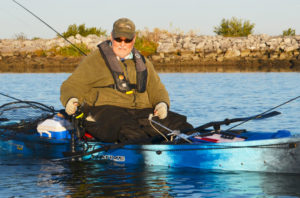
The system came installed on his Native kayak, but it can be ordered off the Internet or purchased at Pack and Paddle in Lafayette, where he buys his kayaks and kayak-fishing goodies.
The small folding or pronged anchors often used in shallow water are entirely ineffective in the pit’s deep waters and hard sandy bottom, he said in a tone that didn’t invite argument.
He did allow that a front and rear anchoring system using two anchors can be used, but that they must be heavy enough not to drag bottom.
Along with the proper weight, any anchors used must be equipped with enough rope. In strong winds and deep waters, an anchor dropped straight down from the kayak likely will not hold.
Tedesco recommended having at least 25 feet of rope on each anchor. The more anchor line is let out, the better the anchor will bite the bottom.
On record with Ted Tedesco
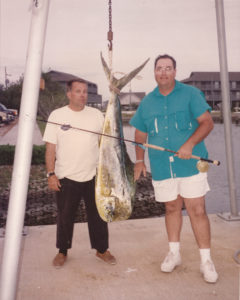
I met Ted Tedesco at a Louisiana Outdoor Writers Association banquet where he was being honored for catching the Fly Fish of the Year for 2015, a 46-pound alligator gar. (He had previously received the same honor in 2013 for a gafftopsail catfish.)
All told, Tedesco has placed 25 fish in the state record books, including (besides the two species above) bluefish, cobia, jack crevalle, dolphin, flounder, ladyfish, little tunny (bonita), Spanish mackerel, king mackerel, pompano, redfish, sheepshead, southern kingfish, black drum, red snapper and blackfin tuna.
“Myron Fisher the guide got me started in records when I caught the state record dolphin,” Tedesco explained. “He did all the paper work and everything. I thought it was cool and started entering more fish.
“For me it was a matter of awareness. I think more people would enter if they were aware of the program. For the most part, I don’t fish for records. They just happen.”
Author’s note: Complete information on the program and applications are found on the Louisiana Outdoor Writers Association website, laoutdoorwriters.com.
From brawn to finesse
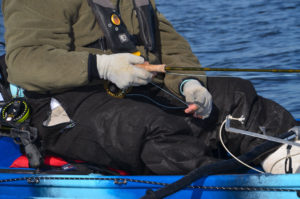
Dr. Victor Tedesco III was born in New Orleans 75 years ago. He grew up fishing, recalling memories of fishing with Larry Brocato, a patient of his physician father. They used croakers that they caught with hand lines for live bait fishing in Lake Pontchartrain.
When he went off to medical school, he flirted with fly fishing. “Some of my fellow students were real good. We would go to Lake Cataouatche to fish for bass.”
But fly fishing didn’t really take on him at the time.
After graduation, he moved to Houma in 1973 to practice medicine, mainly because of the hunting and fishing opportunities the area presented. At first, his main quarry was speckled trout.
Then he started offshore fishing with his father-in-law and brother-in-law. Father-in-law Roy Copeland was one of the founders of the New Orleans Big Game Fishing Club. Mostly they chased marlin, but the pair also introduced Tedesco to tarpon fishing.
In 1976, he got his own offshore boat and began fishing marlin. “I was real serious about the sport, and became a member of the New Orleans Big Game Fishing Club, too,” he said.
“Probably a hundred marlin were caught off my boat. And in 1980 a 412-pound mako shark caught from the boat was recognized as the Louisiana Outdoor Writers Association Fish of the Year.”
Then he abruptly sold the boat in 1988 and got out of bluewater fishing. Former med school classmates and another doctor nudged him back toward fly fishing, so he went to Costa Rica for sailfish and Alaska for salmon
He brought some of the salmon flies back with him and went offshore of Terrebonne with a buddy. “To my surprise, nine of the 11 lemonfish we caught that day were on flies.
“I found out that saltwater fly fishing is a lot of fun and I began teaching myself fly fishing for redfish and trout. I fell in with Dave Coignet, a businessman who was the best fly rod fisherman I’ve ever seen.
“The first time I fished the Forbidden Hole with him, we both caught limits and he had five fish over 5 pounds. I built a camp in Pirate’s Cove on Grand Isle in 1989.
“Now I fish mostly out of the island. I have a 24-foot bay boat and a kayak in Grand Isle, as well as a 20-foot surface drive boat custom built for fly fishing at my home in Houma.
“But probably 90 percent of my fishing is out of Grand Isle. I use a kayak in late fall and in the winter exclusively for fishing the sand pits like the Forbidden Hole. Fishing can be really good there.”
According to Tedesco, speckled trout stack up in the deep waters of the sand pits, especially the one known as the Forbidden Hole. Fishermen, led by a heavy contingent of year-round Grand Isle residents, follow them to fish from the bank, barely off the shoulder of Highway 1.
“The ones that know what they are doing will use long spinning rods, up to 9 feet long and cast all the way over to the drop-offs on the back (south) side of the hole.
“My fly rod can’t reach that far from the bank, so my best success is with my kayak. Plus there are often so many people lined up along the bank, I just let them have it.
“If I can’t catch them now on a fly rod, I don’t get a charge out of catching fish.”
Gearhead
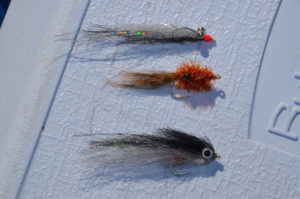
Fly fishermen, as a rule, pay close attention their gear — and Ted Tedesco is no exception — starting with his flies.
If speckled trout are near the bottom, he likes the old standby, a Clouser minnow. It has large metal eyes that serve as weights to keep the lure fishing on the bottom.
Clouser minnows are very effective when the weather is really frigid and the fish are hugging bottom. Its hook rides with the point up, he said. With the other flies the hook rides point-down and often hang up.
“As effective as they are,” he cautioned, “you are handicapping yourself if you only use this fly if the trout are not on the bottom — a Clouser minnow falls too fast through the water column to fish there.”
A very effective lure (and the one he used most of the day in the Forbidden Hole) is an Enrico Puglisi Peanut Bunker (aka Peanut Butter) fly. These are tied to imitate bait minnows, most specifically menhaden, which are called bunkers on the Atlantic Coast.
He also ties shrimp imitation flies for speckled trout fishing. Whatever fly he uses, he has found grays and blacks to be “really good” in the Forbidden Hole.
He ties his flies in more than one size, and he noted that when he is not getting many bites, downsizing from a 2-inch fly to one as small as ¾-inch can trigger strikes.
For this fishing he likes 9-foot, 6- to 8-weight rods. Clouser minnows are heavy and an 8 weight rod is best for their use.
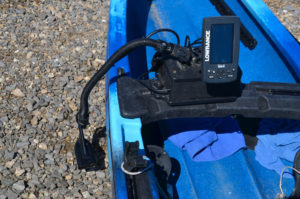
And reels ….
“For specks and reds, you don’t need a real expensive reel. You can get a good one for $200. (That’s cheap?). You are paying for the drag. Expensive reels have a super smooth drag and the line pulls out smoothly,” he explained.
“For trout and most redfish, you will be fighting the fish by stripping. If the fish needs line, you can let it out through your fingers.
“Tippets, part of what rod and reel fishermen call leaders, are usually monofilament. If you are using a small tippet, like a 2-pound class, you may be more likely to need a smooth drag. With a 20-pound tippet, you don’t need a smooth drag.
“I mostly use 20-pound tippets because trout are not leader shy here and 20-pound is abrasion resistant. I also don’t use a shock tippet (a heavier leader piece between the fly and the tippet) for trout or reds. For toothy species they are necessary.”
He stated that for trout fishing, tapered leaders (with a butt section, an intermediate section, a class tippet section and a shock tippet) are not needed because speckled trout fishing doesn’t involve sight-fishing, with a need for perfect fly placement.
Tedesco uses a 3-foot leader on a fast intermediate sinking fly line. For comparison he defined the rate of sink for a fast sinking line as 1 ½ inches per second, and a slow sinking line as a ½-inch per second. Some people do use floating lines here with 9- to 10-foot leaders, he added.
For the average fisherman, he recommended that the weight of the line be matched to the weight of the rod. Tedesco uses weight-forward lines for winter trout fishing rather than level or double-tapered lines.
Finally, on the subject of lines, he observed that fly lines develop memory in cold weather and recommended using cold-water line. “Its core is multi-filament and it has an external coating designed for cold temperatures.”
Two final notes on equipment: The Forbidden Hole has a lot of structure, and it is important for fishermen to learn where the shelves and drop-offs are. A portable depth sounder is invaluable in learning the hole’s bottoms.
The last piece is actually regarding apparel. He wraps ophthalmologists’ tape around the middle finger of his right hand to keep the fly line from cutting into it. Over that he slips Buff fishing gloves that keep the tape in place.
“I can buy finger gloves made for stripping,” he said, “but they lose elasticity quickly.”
Tip of the day
Ted Tedesco resorts often to using a woman’s hair brush to comb out a fly to give it a more natural shape. “If the fly’s fibers snag on themselves, you are wasting your time to fish it,” he said firmly.
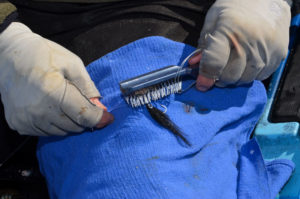
It’s the pits
Victor Tedesco’s favorite winter fishing spots lie snugged up to the south side of Highway 1, between the Highway 3090 fork in the road leading to Port Fourchon and the town of Grand Isle.
From the surface they look like any other water-filled hole in the marsh, but they are very different. They are relicts of mining operations — abandoned sand pits. And they are deep; providential refuge for speckled trout in cold winter weather.
Great east-west running bands of sand lay in the area between the highway and the Gulf. Essentially they are beach dunes and deposits that were stranded inland during periods of marsh expansion (yes, marshes expanded instead of eroded in times past).
Higher ones grew strong stands of live oaks (now largely dead) and were called “cheniers.” Lower ones were gradually submerged beneath marsh, as much of South Louisiana slowly subsided in elevation. But the sand, a valuable building material for humans, was still there.
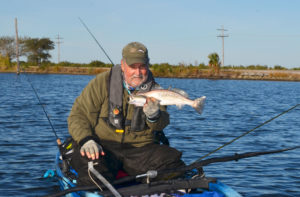
According to Marco Picciola, who knows as much of their history as anyone alive, the first sand pits were dug in the mid-1960s by A. O. Rappolet, and the material was used to build the Port Fourchon Road and to feed sand dunes on Grand Isle itself.
The next excavations were by the Plaisance family, who concentrated on mining the cheniers.
In the late 1970s, Picciola himself, with his brother Larry, went through a seven-year process involving 13 agencies to get permits for them to mine sand. “These were old beach ridges like the cheniers, but without the trees,” he explained.
“The U.S. Army Corps of Engineers didn’t want any more mining on high, wooded cheniers.” To get the permits, the Picciolas had to conduct approved mitigation elsewhere to improve wetland habitats.
This sand was used again at Port Fourchon and in construction of the “new” four-lane Highway 3235 between Larose and Golden Meadow. Their mining was done in the late 1980s and early 1990s.
The deepest of the pits was the one that came to be known as the Forbidden Hole, which was originally dug to 45 feet deep. Seven sand pit cells were strung out along the highway, plus two or three smaller ones dug closer to Grand Isle by the Plaisances for a failed speculative waterfront property development. The best known of these today is called the “Snake Hole” by fishermen.
The Forbidden Hole, also sometimes called the “Telephone Pole Hole,” for the lone telephone pole standing erect in it, is the best known of the pits. “It got its name from ‘them’ trying to run everybody out of there,” grinned Tedesco.
The hole was and still is immensely popular with local, as well as out-of-town, fishermen. It was fenced, re-fenced and re-fenced from the highway multiple times with steel T-posts and barbed wire.
But the fences kept disappearing.
In candid moments, local anglers furtively repeat talk of midnight runs to tie the fences to their trucks’ bumper hitches for “repositioning.” Finally, facing the inevitable, the authorities gave up. While legally still private, they are treated as community property.
Now only about 22 feet deep, the Forbidden Hole is still the deepest water around. It is common to see up to 20 anglers lining the roadside bank of the hole and four or five kayaks, pirogues and even pontoon boats in it, Tedesco said.
“I always stay in the hole itself with my kayak and don’t travel into the surrounding marsh. I don’t want to trespass. I want to keep coming back.”
Best speckled trout fishing in the pits is November through March — the colder the weather, the better. “The best day is the second day after a front comes through and the tide is still low” Tedesco said. “Tide range doesn’t seem to matter as much as it does in speck fishing in the summer.”
Why fly?
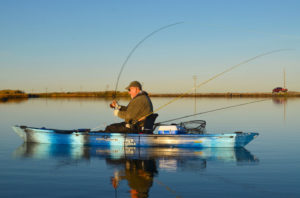
“It’s an art form,” Tedesco bluntly answered. “Once you have some success, it’s exhilarating.
“It’s more of a challenge; it’s more satisfying.
“Any fish you can catch with a rod and reel, you can catch with a fly. I’ve caught blue and white marlin, sailfish, dolphin and peacock bass. Catching a big speckled trout on a fly is as much fun as the more glamorous species.
“Not only is it more satisfying to use a fly, sometimes it is more effective. I was a serious fisherman before I was a fly fisherman. I caught a lot on artificial lures and slaughtered them on live bait.
“When you feel that bite and set the hook on a fly you tied yourself, it is a feeling that is hard to explain.”
Tedesco ties most of the flies he uses, with the exception of spoon-flies. “Dupre spoons are so good, I can’t tie better,” he chuckled. “Some people are so good that their flies are works of art. I can’t put mine in any shows, but they catch fish.”
He encourages people to try fly fishing even if they don’t yet know how to tie flies, citing many sources of supply, mostly on-line. But he says that learning to tie flies is relatively easy.
“Books and on-line videos provide excellent instruction. Joining a fly fishing club can also be helpful. There are clubs in Lake Charles, Baton Rouge, Lafayette and Shreveport — and probably others I don’t know about,” he said.
“You really feel like you accomplished something when you catch a fish on a fly. But, if you don’t work at fly fishing, you won’t be successful.”
